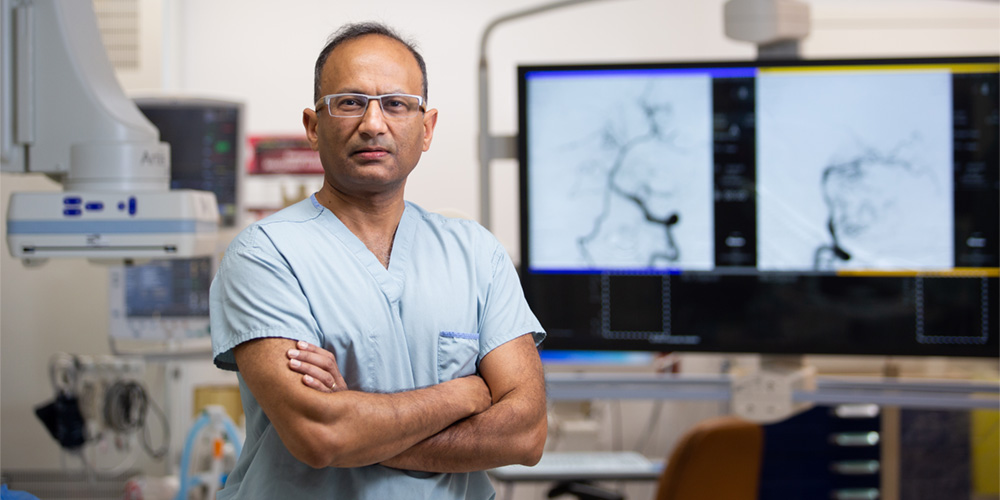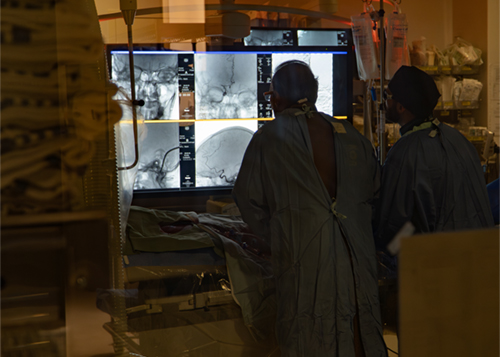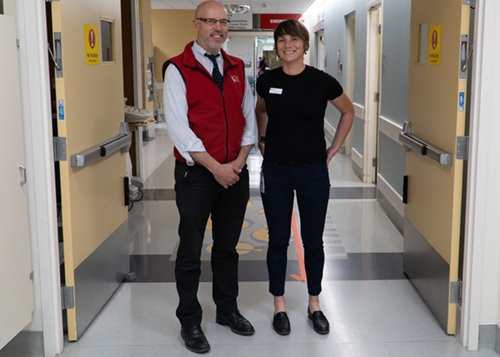Canadian researchers at the centre of ‘groundbreaking and revolutionary’ stroke treatment

At a glance
Issue
Stroke is the second leading cause of death worldwide, killing about six and a half million people annually. In Canada, stroke is the third leading cause of death and the leading cause of adult disability. About 300,000 Canadians are living with the effects of stroke.
Research
Considered to be the most important medical advancement in decades, a research team at the Calgary Stroke Program, a partnership between the University of Calgary and Alberta Health Services, is at the centre of a groundbreaking treatment, endovascular thrombectomy (EVT), that has revolutionized the standard of care for stroke around the world.
Impact
EVT has the potential to save millions of lives and improve quality of life for millions more stroke patients.
If there is an adventure to be had, Roy Mackenzie will find it. He spent much of his life travelling Canada as a pipeline welder. While he made his money on the ground, his passion was in the sky.
“I had a welding career all my life, but flying was what I really loved to do,” says Mackenzie, now 86 years old, from his home in Airdrie, Alberta just north of Calgary.
He became a private pilot at 25 years old touring the prairie skies as a hobby. He jumped out of his first plane skydiving in his mid-70’s. But he says it was doing something mundane in the summer of 2022 that caused his greatest scare.
“I was vacuuming the house and I just dropped to the floor,” Mackenzie explains. “That’s a dangerous job! Don’t do it,” he laughs.
He jokes about it now but at the time he was terrified. Mackenzie had suffered a stroke. His wife Leila called an ambulance and paramedics rushed him to Calgary’s Foothills Medical Centre (FMC).
“I could hear everyone around me talk but I couldn’t speak. I couldn’t move my right leg or arm,” recalls Mackenzie.
A CT scan confirmed Mackenzie suffered a medium vessel occlusion (MeVO) ischemic stroke. It happens when a blood clot occurs in a medium sized artery in the brain, cutting off blood supplying critical nutrients such as glucose and oxygen, resulting in brain cells beginning to die within minutes. When he arrived at Foothills, he says doctors immediately gave him thrombolytic medication, commonly known as a clot buster, but it didn’t help. That’s when he was asked if he wanted to be part of a clinical trial that was testing a new stroke treatment. He agreed.
A “miraculous” recovery
“I was lying there and I could see the doctor's screen,” Mackenzie explains. “I could see the blocked vessel, it looked like shadowed fingers in my brain, and then all of a sudden the clot on the screen started to move. I could feel pressure in my head and then I just passed out.”
Mackenzie was moved to recovery. When he woke up the next day, he could speak, move his arm and leg. The day after that, he was walking around, climbing stairs and could use the bathroom independently. Four days later he was released from hospital.
“I saw other people in the beds beside me and they couldn’t move or do anything and here I was walking and talking and feeling back to normal,” Mackenzie thought. “It was a miracle.”
Mackenzie’s miraculous recovery wasn’t an over exaggeration because in Canada stroke is the leading cause of adult disability and the third leading cause of death. If they survive, 75 percent of Canadians who suffer a stroke are left with minor to severe long-term disabilities, putting pressure on the health care system and loved ones who quite often are forced to become caregivers.
Endovascular thrombectomy (EVT) in treating stroke the most groundbreaking medical advancement in decades
The study, Mackenzie agreed to be a part of, is the worldwide randomized ESCAPE MeVO trial headed by Drs. Mayank Goyal and Michael Hill and the team with the Calgary Stroke Program (CSP). Funded by the Canadian Institutes of Health Research (CIHR), researchers are investigating the validity of using endovascular thrombectomy, commonly known as EVT, as a way of removing clots in medium sized blood vessels.

During EVT, doctors insert a catheter into the patient’s groin, then using medical imaging, guide a wire through the body and into the vessels in the neck. Doctors then place a tiny tube, or stent, in the blocked blood vessel that often measures a millimetre in size or even less, where the blockage is located and insert a device to remove the clot.
“We’ve seen patients who come in with a massive stroke and the next day they go home,” says Dr. Goyal, principal investigator of the ESCAPE MeVO trial, professor at the University of Calgary, neuroradiologist at FMC, and a world-renowned expert in stroke research. “We’ve seen incredible recoveries. That’s what makes this treatment so revolutionary.”
Revolutionary indeed. In fact, EVT has proven to be the greatest medical breakthrough in stroke treatment in decades, much of that is thanks to Dr. Goyal, Dr. Hill and their colleagues with the CSP led by Dr. Andrew Demchuk. The CSP is a collaboration between the University of Calgary and Alberta Health Services (AHS).
In 2013, the trio launched the original ESCAPE trial evaluating the use of EVT in treating ischemic strokes in large vessel occlusions. The Calgary team worked with researchers doing their own similar studies at 22 sites around the world. The early results showed that EVT more than doubles a patient’s chance of once again living an independent life and triples their chance of making a full recovery.
Those staggering results abruptly halted the study in 2015 to immediately make EVT the standard of care worldwide when treating stroke in large vessels. ESCAPE MeVO is the next generation trial, as the team investigates if EVT can show that same success in smaller, medium sized vessels.
“It’s tougher to navigate devices through a medium sized vessel as opposed to larger ones,” explains Dr. Goyal. “We are fortunate to not only be working alongside researchers all over the world to help us increase the number of patients in the trial, but also with private industry creating innovative imaging techniques to more easily diagnose MeVOs and explore improved devices tailored to open smaller vessels.”
Imaging innovations key to success

“Some of our success is because of our hard work and some of it is a ‘historical accident’ because we were in the right place at the right time,” adds Dr. Hill, ESCAPE MeVO co-principal investigator, professor at the University of Calgary, neurologist at FMC, director of the Cardiovascular Health and Stroke Strategic Clinical Network at AHS, and recently named Officer of the Order of Canada for his contributions to stroke research.
Dr. Hill says these breakthroughs in stroke would not have happened 20 years ago because the technology wasn’t developed to support them. Improved MRI and CT scan imaging make it possible to explore blood vessels and identify clots at a high resolution. Without the technology EVT wouldn’t be possible. He says ESCAPE MeVO’s goal is to give more patients independence after a stroke.
“It’s very expensive when people have a neurological disability. If they can’t walk, can’t talk, can’t eat or if they can’t shower, that puts a huge strain on the health care system,” explains Dr. Hill. “With ESCAPE MeVO, we’re looking at patients with more moderate strokes. We don’t expect to save more lives, but what we do expect to see is a reduction in disability. If we can get people back to a functional status, living independently and maintaining a quality of life, we think that would be a terrific outcome.”
Canadian team world leaders in stroke research

To increase the ESCAPE MeVO trial patient pool, the Foothills team is working with a global network of researchers in Canada, the United States, United Kingdom and Germany. Their groundbreaking work is attracting a new generation of research talent.
“I stumbled into stroke research after meeting Dr. Goyal. The team’s research is why I came to Canada,” says Dr. Johanna Ospel, a radiologist who was born in Germany, trained as a physician in Switzerland and is now part of the ESCAPE MeVO team, starting her clinical fellowship at Foothills.
“I’ve been doing stroke research for quite a while and I’ve written so much about EVT. Now I will actually get to perform the EVT procedure on patients myself. It really is a full circle moment,” adds Ospel.
While Dr. Goyal says hundreds of people worldwide have played a critical role to make these trials happen, he admits if ESCAPE MeVO proves successful it will be a great Canadian story, giving patients like Roy Mackenzie their independence back. But their work, he says, is far from over.
“EVT in stroke treatment has been a major step forward but it’s not the be all and end all,” says Dr. Goyal. “When we look at the data, even after EVT, we still have patients who die from the disease and we still have patients who are left with significant disability. It tells us we still have a long way to go. Patient lives are really at the centre of all the work we do.”
- Date modified: